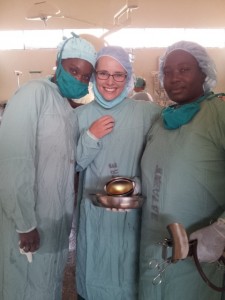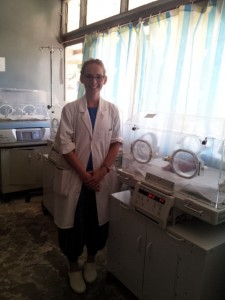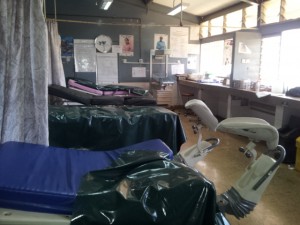To start with this week, I have some excellent news on the man from my last blog who had the lower leg amputation. He is doing well, and looks a lot happier with life now that the pain is at a level where he is able to sleep. The stump is still oozing but it is hoped it will dry up over time. Fingers crossed.
This blog focuses on my time in Maternity, undoubtedly the biggest department of the hospital and definitely a place of action. Every day I left the ward exhausted. It was not such easy going at times.
Maternity is manned by two senior medical officers and two medical interns, quite a lot of man-power in Siaya Hospital terms. There is also a consultant surgeon who comes twice weekly, on a Monday for a ward round and a Friday for elective gynecology surgeries.Ten to fifteen babies a day arrive in Siaya Hospital and usually two or three during the night. Hence, two hundred births a month is a quiet month and 300 a busy month. Culturally, women usually start their families early and have on average 5-6 children. However, seeing a mum for her 10th or 11th birth is still quite common.
Maternity care here is basically a hospital run service. Once a women figures out she is pregnant she may or may not come to the Maternal and Child Heath department where I was stationed first. Here they are checked for HIV and anaemia, are given folate and iron tablets, a women and child health booklet, a very brief physical examination for fetal growth, a tetanus toxoid injection and a mosquito net. They are encouraged to come back to the hospital every month from then on for a similar check up and once Mum reaches the second trimester they are started on Malaria prophylaxis.
A mother will hopefully be seen 4 or 5 times during her pregnancy but many are seen only once or not at all before arriving in labour to the hospital. A small number of mother’s choose to give birth in the community, but it is most common for women to have their babies in hospital which is probably the safest option here.
We had one very unfortunate cases of a young, first time mum who had gone in to labour and attended a community health clinic as her chosen place to give birth. The nurse there gave her an episiotomy despite only being in the first stage of labour (which can be many hours long) and sent her home. Her neighbor found her, realised all the blood was not normal and brought her to hospital. We delivered a baby boy about 2 hours later who required significant resuscitation, but started to breath eventually. The damage was repaired and both baby and mum are now doing OK. A tough start to motherhood for her.
If mothers experience any issues during pregnancy, such as bleeding or fevers, they must come to the hospital and may be admitted to the antenatal ward for assessment and treatment. When a women begins labour she is assessed and if she is determined to be in the first stage of labour, she is admitted to the “first stage” ward.
When she is about to have the baby she is transferred to the delivery ward which has curtain-less windows along one entire side and 4 beds rowed up beside each other (forget about the possibility of having any privacy). Often two women are giving birth bedside each other and another one or two waiting to have vaginal examinations to see how their labour is progressing.
They are then transferred to the postnatal ward after delivery with most Mums staying for 12 hours before returning home to the care of their families. Then there is a post c-section ward, the nursery ward for the pre-term and special needs babies, and the gynaecoloy ward for post elective surgery patients. That is a quick run down of the maternity set up here in Siaya.I have again been getting well acquainted with theatre during my time in maternity, assisting the doctors with a number of c-sections and acute obstetric cases. Like my time on the general surgery team, I have really been able to get some amazing clinical experience, performing examinations, delivering a very healthy baby boy, suturing up abdomens and placing a spinal anesthesia for a c-section.
I must say that given the case I told you about in my last blog, the nerves were certainly a bit frayed by the end of giving the spinal (which was complication free by the way 🙂 ). However, I decided if I don’t learn how to do such procedures now, when my first try comes around in the future, later this year, next year or the year after, I will still be just as nervous then. So I have decided that there is no time like the present.
My general observation is that Mum usually presents late when symptoms are severe, having no idea that epigastric pain or swelling of the extremities she has been experiencing is an indication she is heading for a crisis. All those complications I read about during my obstetrics run last year, eclampsia, ruptured uterus, placenta previa and abruption, post partum hemorrhage, cord prolapse have turned from words on a page to real life experiences. Unfortunately investigations are limited and clinical suspicion is the main driver of management. The ward has a CTG machine which they don’t use because, quote, “it has run out of paper.”
C-sections are a common emergency surgery at least three times a day for prolonged labours, meconium stained liquor, previous c-sections … the list of reasons and indications is long. With the late presentations as I mentioned, the outcomes are not always what is hoped for.
One particular case I have been involved in was an 18 year old who was referred to hospital with a non-progressing labour and foetal distress. Two hours later she was in theatre and we were performing a c-section. Unfortunately baby was not in a very good state. He had passed meconium already and could not be revived.
Mum had taken herbal medicine for pain which also acts to decrease uterine contractions and effects the efficiency of the placenta. It is not the first time I have come across patients with herbal intoxication. Most patients don’t know what they have taken exactly, all they know is that it is suppose to help. Herbal medicine is still widely used and on my way to the hospital I pass at least three signs for herbal doctors.
Unfortunately, seven days later we were back with this young lady as her wound had broken down and was discharging significant amounts of pus. When we opened we had much more than we bargained for. She had developed a fistula between her rectum and vagina and there was significant amounts of fecal matter discharging in to her abdomen.
The prolonged labour due to the effects of the herbal medicine and late referral meant baby was compressing maternal tissue and vessels stopping adequate blood supply causing the tissue to become necrotic, a risk factor for fistula formation. The medical officer tried to repair the defect in the intestine but the tissue was very friable. It really is a watch and wait case with everyone hoping the hole will repair itself over time.Ectopics are another fairly frequent emergency surgery. For any women presenting with a lot of abdominal pain and signs of blood loss (which can be significant and rapid), ectopic pregnancy is at the top of the differential. One case was a 19 year old who presented with signs suggestive of an ectopic and she was booked for an explorative laparotomy. The surgeon checked the most likely place, the fallopian tubes first then moved the uterus to see if the ectopic was behind this organ as in our last case the day before.
The uterus literally fell apart. It turns out that instead of an ectopic is was a septic miss-carriage. Mum had tried to get rid of the pregnancy herself, introducing infection which had severely damaged her uterus, The surgeon did her best to repair but as in the case above, infection damaged tissue is very hard to repair. It is possible she will never end up conceiving and if she does, her uterus will have a weak section which will be a risk for rupture.
I feel like the stories in this blog are all a bit morbid so just to reassure you, most births progress normally and Mum ends up with a very healthy bundle in her arms. I guess we are always involved in the complicated cases and it can result in a bit of a skewed perspective of one of the most normal processes in life. Being involved with some of these incredibly important complications are some of the most important learning experiences I will bring back with me.
This weekend I ventured to Hell’s Gate, the smallest national park in Kenya and the home of the Lion King … it had to be done really. It is also where some of Tomb Raider was filmed. Its name arose when Mt Longonot on the edge of the park exploded killing many Maasi people who lived in the area, after which they called it hell. It is a hot spot of geothermal activity which is being harnessed to pump many kilowatts of power into the Kenyan power grid.It is possible to walk down a deep gorge to “Hell’s shower” which is near boiling water arising from the ground and out of the rock. The park also doesn’t have any of the major predators, so you are able to mountain bike through the park next to buffalo, zebra, giraffe and lots of pumba’s and wee pumba babies.





No comments yet.
Leave a comment